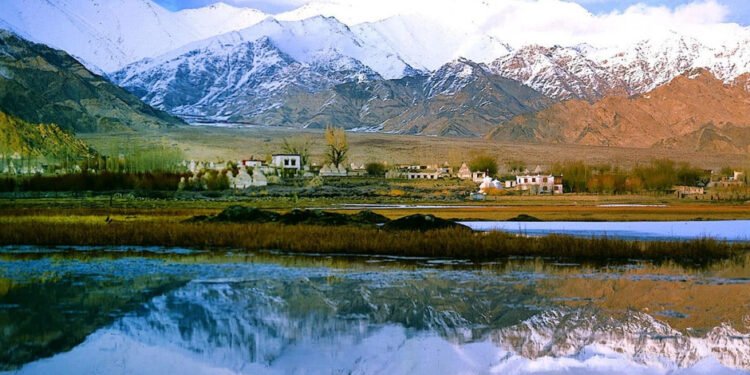Ladakh, the “Land of High Passes,” is a breathtaking canvas of dramatic landscapes, ancient monasteries, and rich cultural heritage. Nestled in the northernmost region of India, it promises adventure and serenity, captivating the hearts of travellers.
This guide aims to unveil the wonders of Ladakh, offering insights into essential attractions and experiences. From the mesmerising blues of Pangong Lake to the rugged terrains of Nubra Valley, prepare for an unforgettable journey through this enchanting region, where each corner tells a story eager to be uncovered.
Best Time to Visit Ladakh
Peak Season (June to mid-September)
- Pleasant day temperatures, ideal for sightseeing and activities
- Stunning views with clear blue skies
- All attractions and activities available
- Gets very crowded, so book in advance
Off-Peak Season (Mid-September to November & March to mid-June)
- Avoid extreme cold (in winter) or sudden snowfall (in autumn/spring)
- Fewer tourists, better deals on hotels
- Some high passes closed due to snow
During summer, temperatures typically range from 15°C to 30°C, while winter can see them drop to as low as -20°C. It’s essential to check local forecasts before your trip, as weather can shift quickly in this high-altitude area.
Getting to Ladakh
By Air
The nearest airport is Kushok Bakula Rimpochee Airport in Leh, well-connected with Delhi and Srinagar.
By Road
The thrill of crossing mountain passes like Taglang La (17,480 ft) and Khardung La (17,582 ft) on the road is an experience in itself! The two popular routes are:
- Srinagar-Leh (430 km): Traverses Zoji La pass (11,575 ft)
- Manali-Leh (485 km): Crosses Baralacha La (16,040 ft) & Tanglang La (17,480 ft) passes
- Permits: Required for non-Himachalis to travel on the Manali-Leh highway
Certain areas in Ladakh, such as Nubra Valley and Pangong Lake, require special permits. These can be obtained from the District Commissioner’s office in Leh. Ensure you carry valid identification and have photocopies of essential documents for a hassle-free experience.
Must-Visit Attractions
1. Pangong Lake
One of the crown jewels of Ladakh, Pangong Lake is famous for its breathtaking azure waters, which shift in colour throughout the day. This high-altitude lake across India and Tibet offers picturesque views and is perfect for photography and tranquil moments by the shore.
2. Tsomoriri Lake
Less crowded than Pangong, Tsomoriri Lake is equally stunning, surrounded by snow-capped peaks and vast landscapes. This serene spot is ideal for nature lovers and birdwatchers, with opportunities to see migratory birds.
3. Nubra Valley
Known for its stark beauty, Nubra Valley is accessible via the world’s highest motorable road, Khardung La. Visit Diskit Monastery, home to a giant Buddha statue, and explore the Hunder Sand Dunes, where you can ride camels against a backdrop of mountains.
4. Leh Palace
This historical palace, built in the 17th century, offers a glimpse into Ladakh’s royal past. Climb to the top for panoramic views of Leh and the surrounding landscape, and explore the fascinating architecture and artefacts within.
5. Shanti Stupa
Situated atop a hill, the Shanti Stupa symbolises peace and offers stunning panoramic views of the Leh Valley. The serene atmosphere and beautifully maintained gardens make it a must-visit, especially at sunset.
Adventure Activities
1. Trekking
Trekking in Ladakh is every nature lover’s dream, with routes traversing breathtaking landscapes, high mountain passes, and quaint villages. Famous multi-day treks like the Markha Valley, Snow Leopard Trek and Stok Kangri Trek need an expert guide to navigate through glaciers and avalanche-prone areas.
Markha Valley crosses two high passes – Ganda La (16,900 ft) and Kongmaru La (17,060 ft) while offering views of the Stok Range and Karakoram mountains—The challenging Stok Kangri trek culminates at the summit of Stok Kangri Peak, which stands at an impressive 20,187 feet.
2. Camping
Imagine waking up to the breathtaking sight of majestic Himalayan peaks like Kang Yatse on one side and expansive valleys sprinkled with small villages on the other.
Camp under the clear, starry skies at Pangong Lake, where the deep blue waters mirror the brown mountains, or at Tso Moriri, where the emerald green lake contrasts beautifully with snow-covered peaks. Experience the stunning meadows of Nubra Valley for a truly extraordinary adventure.
The Ladakh sky at night, with endless stars and multiple shooting stars, is sure to take your breath away.
3. Mountain Biking
Cycling along the Manali-Leh highway as it winds its way through high passes like Baralacha La (16,040 ft), Lachlung La (16,616 ft), and Tanglang La (17,480 ft)—some of the highest motorable passes in the world—, is an exhilarating yet challenging adventure for every thrill-seeker.
The route cuts through rough terrain with steep climbs, sharp descents, and breathtaking valley views, making it the ultimate biking challenge.
4. River Rafting
Face the icy waters of the Zanskar River as you navigate thrilling Grade III and IV rapids, such as the Wall and Satan’s Horn. The journey down the entire 150-kilometer river takes about 14 days, leading you through breathtaking gorges.
The best season for river rafting in Ladakh is from June to early September when the waters swell with the melting snow.
Comfortable Stays & Delicious Food
Accommodation
Ladakh offers varied stay options to suit every budget—from luxurious 5-star hotels with excellent amenities and lavish decor to budget homestays located in the interiors of villages with basic facilities but an authentic cultural experience.
Cuisine
Ladakhi food has a distinctive Tibetan influence, evident in wontons, momos, and noodle preparations. Sample authentic dishes like sky – handmade pasta with vegetables or meat; alu dom – spicy potato curry; thukpa noodle soup with veggies or lamb, and shape – a hearty lamb stew with wheat and time steamed bread.
Wash it down with gurgur cha, the salty Ladakhi butter tea. Other must-try items are khambir (local bread) with apricot jam and hearty yak cheese.
Cultural Experiences
Monasteries and Gompas
Ladakh has numerous monasteries and gompas, each with its history and significance. Places like Hemis, Thiksey, and Lamayuru offer insights into Buddhist culture and traditions, often with stunning architecture and serene surroundings.
Local Festivals
The vibrant festivals of Ladakh, such as the Hemis Festival, showcase the region’s rich cultural heritage through traditional dances, music, and rituals. Attending these festivals provides a deeper connection to the local community and its customs.
Interaction with Locals
Engaging with the friendly locals can enhance your travel experience. From sharing stories to enjoying a cup of traditional tea, these interactions offer valuable insights into Ladakhi life and culture.
Conclusion
As you wander through this magical wonderland with some of the world’s highest motorable passes, bluest waterbodies, greenest valleys and coldest deserts, Ladakh will surely make you fall in love with its raw and untouched beauty.
For a seamless experience, consider exploring Ladakh tour packages that cover all the must-visit attractions and activities, ensuring you make the most of your adventure. Pack your bag and get ready to explore this enchanting land of high passes.












